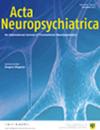调节快乐和幸福的电路——关注电路的潜在生物标志物,包括Habenuloid复合体。
IF 2.5
4区 医学
Q1 Medicine
引用次数: 8
摘要
引言中枢神经系统中神经元连接的多样性和复杂性使得很难解开在(神经)精神疾病的发展或治疗中发挥重要作用的回路。通过选择前脑的进化发展作为起点,可以在连接中创建一定的顺序。间脑背侧连接(DDC)系统可用于开发可预测治疗反应的生物标志物。材料和方法在简要介绍该理论后,我们检查了关于DDC系统连接的神经解剖学出版物。然后,我们寻找对缰核有特异性的神经化学成分。结果和讨论寻找反映缰核连接功能的生物标志物的最佳策略是使用该复合物特异的受体、转运蛋白或酶的遗传变体。通过用探针激活这些,并测量具有不同功能基因型的人的反应,可以评估生物标志物的有用性。结论在这方面最有前景的生物标志物是那些与尼古丁受体、多巴胺D4受体、μ-阿片受体的激活或抑制有关的生物标志,以及那些与缰核神经胶质细胞(星形胶质细胞和小胶质细胞)的功能有关的生物标记。本文章由计算机程序翻译,如有差异,请以英文原文为准。
Circuits Regulating Pleasure and Happiness - Focus on Potential Biomarkers for Circuitry including the Habenuloid Complex.
INTRODUCTION
The multiplicity and complexity of the neuronal connections in the central nervous system make it difficult to disentangle circuits that play an essential role in the development or treatment of (neuro)psychiatric disorders. By choosing the evolutionary development of the forebrain as a starting point, a certain order in the connections can be created. The dorsal diencephalic connection (DDC) system can be applied for the development of biomarkers that can predict treatment response.
MATERIALS AND METHODS
After providing a brief introduction to the theory, we examined neuroanatomical publications on the connectivity of the DDC system. We then searched for neurochemical components that are specific for the habenula.
RESULTS AND DISCUSSION
The best strategy to find biomarkers which reflect the function of the habenular connection is to use genetic variants of receptors, transporters or enzymes specific to this complex. By activating these with probes and measuring the response in people with different functional genotypes, the usefulness of biomarkers can be assessed.
CONCLUSION
The most promising biomarkers in this respect are those linked to activation or inhibition of the nicotine receptor, dopamine D4 receptor, μ-opioid receptor and also those of the functioning of habenular glia cells (astrocytes and microglia).
求助全文
通过发布文献求助,成功后即可免费获取论文全文。
去求助
来源期刊

Acta Neuropsychiatrica
医学-精神病学
CiteScore
8.50
自引率
5.30%
发文量
30
审稿时长
6-12 weeks
期刊介绍:
Acta Neuropsychiatrica is an international journal focussing on translational neuropsychiatry. It publishes high-quality original research papers and reviews. The Journal''s scope specifically highlights the pathway from discovery to clinical applications, healthcare and global health that can be viewed broadly as the spectrum of work that marks the pathway from discovery to global health.
 求助内容:
求助内容: 应助结果提醒方式:
应助结果提醒方式:


